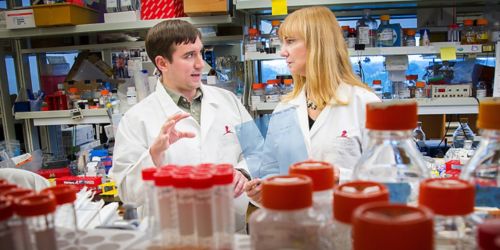St. Jude Family of Websites
Explore our cutting edge research, world-class patient care, career opportunities and more.
St. Jude Children's Research Hospital Home

- Fundraising
St. Jude Family of Websites
Explore our cutting edge research, world-class patient care, career opportunities and more.
St. Jude Children's Research Hospital Home

- Fundraising
A vaccine to prevent ear infections? Here’s the latest.

A vaccine to prevent ear infections will soon be here – it’s the first of several vaccines Jason Rosch, PhD, has worked on for clinical development. He credits Elaine Tuomanen, PhD, for preparing him to think about how or if their work may be useful in the clinic.
What’s the most common reason parents schedule doctors’ appointments for their children?
Ear infections
Five out of six children in the U.S. will have at least one ear infection before they celebrate their third birthday, according to the National Institute on Deafness and Other Communication Disorders. In fact, ear infections caused by the Streptococcus pneumoniae bacteria are one of the most common infectious diseases worldwide. In the U.S., ear infections are the most common problem for which antibiotics are prescribed.
The bacterium causes 6 million infections annually in the U.S. It is also a leading cause of pneumonia, which is the single largest cause of death in children worldwide. It is also the largest killer in the elderly.
Current pneumococcal vaccines are effective at preventing blood infections (sepsis) and other invasive diseases. But the shots provide limited protection against pneumococcal infections that begin in the upper respiratory track and cause ear infections, sinusitis and pneumonia.
Closing the vaccine protection gap
That helps to explain why early in his career Jason Rosch, PhD, of the St. Jude Children’s Research Hospital Department of Infectious Diseases, joined a project led by Elaine Tuomanen, PhD, and Jon McCullers, MD, to create a vaccine to close the pneumococcal protection gap. Tuomanen chairs the St. Jude Infectious Diseases department where McCullers was a member. Today McCullers chairs the University of Tennessee Department of Pediatrics.
Those efforts have yielded the first effective experimental vaccine against pneumococcal ear infections in animal models. Blue Water Vaccines, an Ohio-based biopharmaceutical company, recently licensed the technology to develop a human vaccine.
Targeting vulnerability
Current vaccines generate antibodies that bind to the S. pneumoniae’s polysaccharide (sugar) capsule and promote the germ’s destruction. But few of antibodies bind antigens (protein) on respiratory tissue and protect against pneumonia, ear and sinus infections. Current vaccines also protect against fewer than two dozen of the more than 100 different capsules (serotypes).
St. Jude researchers took a different approach for their vaccine. They created a genetically modified (attenuated), less adaptable version of the bacteria. The changes mean the bacterium could not spread the infection. The attenuated virus was also associated with less tissue damage and inflammation in mice and did not cause sepsis.
The experimental vaccine also triggered broader immunity against multiple different pneumococcal components and protected against infections in mice and chinchillas.
“The vaccine provided excellent protection against acute otitis media, sepsis and pneumonia even when the mice were co-infected with influenza,” Rosch said.
Next steps
Blue Water Vaccines executives visited St. Jude recently to discuss next steps to prepare the vaccine for an expected clinical trial beginning in healthy adults.
For Rosch, this is an exciting time. He had just finished a postdoctoral fellowship in Tuomanen’s laboratory when the Streptococcus pneumoniae project began. “My mother’s pretty excited,” said Rosch with a laugh.
This is the first of several vaccines he has worked on to be licensed for clinical development. “With vaccines, you reach a point in development when industry or biotech partners are necessary to move the project forward,” he explained.
“I got interested in pathogens and how they cause disease as an undergraduate,” Rosch said. In graduate school he took a deep dive into molecular microbiology and microbial disease. “When I came to St. Jude for a postdoc, I wanted to understand how pathogens interact with the host and how to target them and break the disease cycle.
“Elaine really pushed postdocs to think about how or if their work might ever be useful in the clinic. Almost everyone gets ear infections. I hope this vaccine will change that.”






